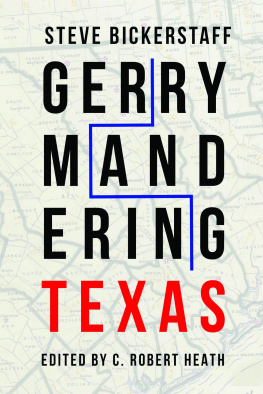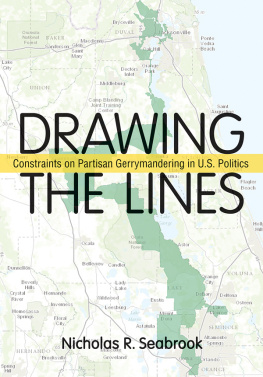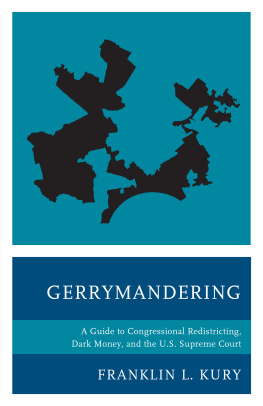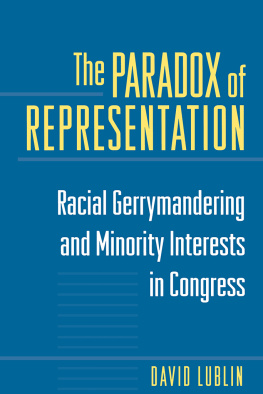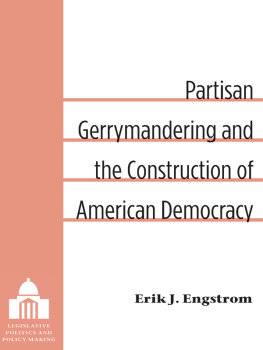Gerry
mand
ering
Texas
STEVE BICKERSTAFF
Gerry
mand
ering
Texas
EDITED BY C. ROBERT HEATH
TEXAS TECH UNIVERSITY PRESS
Copyright 2020 by Texas Tech University
All rights reserved. No portion of this book may be reproduced in any form or by any means, including electronic storage and retrieval systems, except by explicit prior written permission of the publisher. Brief passages excerpted for review and critical purposes are excepted.
This book is typeset in Crimson Text. The paper used in this book meets the minimum requirements of ANSI/NISO Z39.48-1992 (R1997).
Designed by Hannah Gaskamp
Cover image used with permission from The Texas General Land Office
Library of Congress Control Number: 2020942538
ISBN 978-1-68283-073-4 (paperback)
ISBN 978-1-68283-074-1 (ebook)
Printed in the United States of America
20 21 22 23 24 25 26 27 28 / 9 8 7 6 5 4 3 2 1
Texas Tech University Press
Box 41037
Lubbock, Texas 79409-1037 USA
800.832.4042
ttup@ttu.edu
www.ttupress.org
Contents
Illustrations and Maps
1812 gerrymandering cartoon
US congressional districts, 20192020 elections
Texas congressional districts, 18461848 elections
Texas congressional districts, 18741878 elections
Texas congressional districts, 19581964 elections, with arrow to Dallas County
Texas congressional districts, 19581964 elections, with arrow to Midland and Ector Counties
Texas congressional districts, 1966 elections, with arrow to Midland and Ector Counties
Texas congressional districts, 1996 special elections and 19982000 general elections
Texas congressional districts, 2002 elections
Texas congressional districts, 2004 elections and 2006 primaries
All congressional maps courtesy of the Texas Legislative Council
Foreword
Steve Bickerstaff, the author of this book, was my friend. For eighteen years he was my law partner. Although the law practice (currently Bickerstaff Heath Delgado Acosta LLP) that the two of us founded in 1980 has grown and undergone various name changes both before and after his retirement in 1998, his surname has always been first among the names that identify the firm.
Not long after finishing revisions on this book, Steve unexpectedly died. While there remained some minor editing to complete, the product is wholly Steves. There was no one better able to write this story. To a large extent, Texas redistricting was Steves life. This is not to diminish the other important aspects of his lifehis family, his career, his love of travel and the outdoorsor to suggest that it held a place superior to that of other personal and professional facets of his being. Rather, the story of Texas redistricting and Steves professional life overlapped substantially across a long and meaningful period. It is doubtful that there are many, if any, persons who had such a deep involvement in these issues over such an extended and critical period in the history of Texas redistricting. Thus, as readers go through the following chapters, they will have the benefit of the perspective of an author who was, in the words of the musical Hamilton , literally in the room where it happened.
From 1974 to 1976, Steve served as parliamentarian of the Texas Senate. While that span did not include a decennial redistricting session, it gave Steve the opportunity to gain a real insight into the legislative process and an understanding and appreciation of the members and leaders of the legislatureknowledge that would be invaluable in subsequent years as he advised legislators during the redistricting process and defended their actions in the courts.
Following his service as senate parliamentarian, Steve became an assistant attorney general under Attorney General John Hill. As a special assistant and later as the chief of the State and County Affairs Division of the Office of the Attorney General, Steve assumed responsibilities in defending the state in the ongoing lawsuits that lingered following the redistricting that reflected the results of the 1970 census. This included the landmark case of Graves v. Barnes (later White v. Regester ) discussed in this book.
When John Hills tenure as attorney general ended in 1978, Steve moved to San Antonio to work with the legendary Herb Kelleher, one of the founders of Southwest Airlines, who at the time was general counsel of the airline company and a partner in his own law firm. Steve worked on the legal issues associated with Southwests transformation from an intrastate to an interstate airline. During that time, he also had a contract with the Texas Senate to prepare a legal and historical guide to redistricting for the use of the Texas Senate in the coming 1981 legislative session, when the legislature would redistrict following the publication of the 1980 census.
Steve decided to leave the San Antonio practice and invited me to join him in starting our own two-person law firm, Bickerstaff, Heath LLP; the contract with the senate was one of our first pieces of legal work. The analysis he produced pursuant to that contract was subsequently published in book form by the Texas Legislative Council, an abridged version of which can be found as Reapportionment by State Legislatures: A Guide for the 1980s, SMU Law Review 34:2 (1980). More important, it became a resource for both the House and senate as they undertook the task of drawing legislative districts that, due to the 1975 extension to Texas of Section 5 of the Voting Rights Act (VRA), would be required for the first time to be submitted to the Department of Justice for preclearance before those newly adopted districts could be used in an election. As discussed in more detail in chapter 6, the complexities in that process ran the gamut of issues that can come up in legislative redistricting.
While the guide Steve wrote for the Texas Senate largely set the template for the redistricting effort, lawmakers did not always follow his recommendations. In particular, the Texas House of Representatives decided not to follow his advice on avoiding cutting county boundaries in favor of conflicting, but more politically palatable, advice from some lawyer-legislators. As a result, the House districts were found to violate the state constitution. During that redistricting session, the two houses of the legislature were controlled by Democrats, but the governor, Bill Clements, was a Republican.
Because the way district lines are drawn can have a decided partisan effect, any instance in which a state is under divided political control makes it difficult to yield a final redistricting product. In this case, the Republican governor vetoed the redistricting plan adopted by the Democrat-controlled senate. Since the House plan had been invalidated by the Texas Supreme Court because of its failure to respect county boundaries and the senate plan had been vetoed, the task of drawing legislative districts passed to the Legislative Redistricting Board (LRB)a body established by the state constitution to assume the redistricting task if the legislature failed to successfully adopt a plan.
The LRB consists of the lieutenant governor, the Speaker of the House, the attorney general, the comptroller of public accounts, and the commissioner of the General Land Office. Steve then had the opportunity to advise the LRB and later to defend the legislative and congressional plans when they were challenged in court. This included his work in Upham v. Seamon , a landmark case that defined the relationship between the courts and the legislature when it comes to adopting maps.

